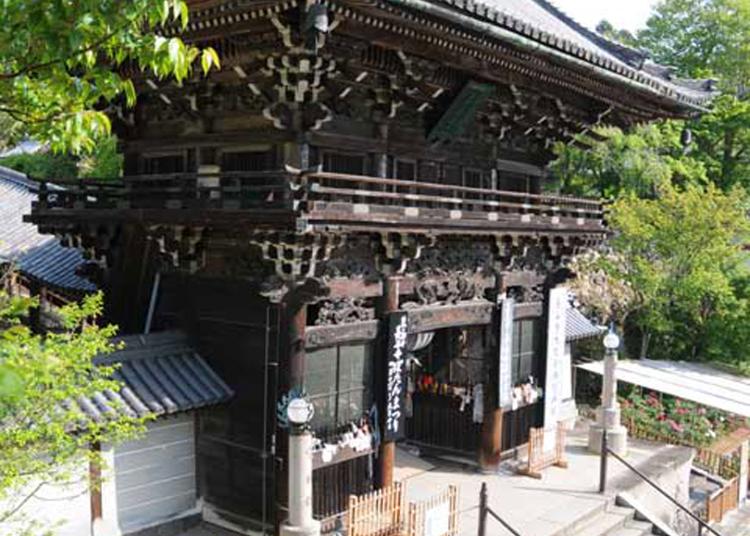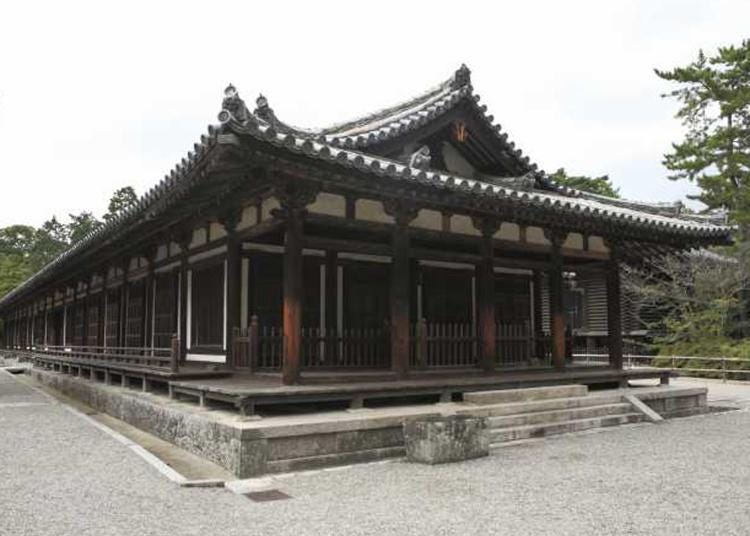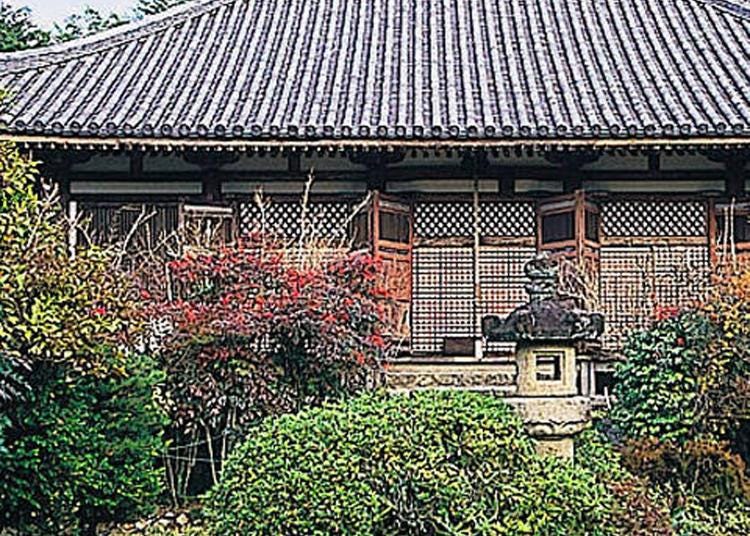
Discover the top ten temples in Nara, as curated by LIVE JAPAN, a premier travel website for visitors to Japan. This ranking is based on the most popular pages viewed by international travelers, offering the best travel tips and insights.
1. Todai-ji Temple

Commanding the northern end of Nara Park, Todai-ji Temple was established by Emperor Shomu in the eighth century. Its principal image is Rushana Daibutsu, or Daibutsu-sama, one of the world's largest bronze Buddhist statues, standing serenely at 15 meters high. This magnificent statue resides in the Great Buddha Hall, renowned as one of the world's largest wooden buildings, measuring 57 meters wide, 50 meters deep, and 48 meters high. Flanking the pathway to the temple are two statues of Kongo Rikishi, housed in the 25.5-meter-high Nandai-mon gate, along with komainu (imperial guardian lions) to ward off intruders. Many of the temple's structures and treasures have been designated as National Treasures and Important Cultural Properties. Additionally, Todai-ji Temple is a UNESCO World Heritage site, recognized as one of the eight Historic Monuments of Ancient Nara.
Surviving Two Wars, Daibutsu-sama Continues to Shine
In 752, a grand ceremony consecrated Daibutsu-sama. On the orders of Emperor Shomu, who wished for the happiness of all, the temple was built with the cooperation of 2.6 million people, about half of Japan's population at the time. After wars at the end of the Heian period and during the Warring States Period damaged the statue, people rallied to repair it. The present pedestal and lap have remained unchanged since the Nara period.
Todai-ji Museum: Home to Precious Cultural Assets
The Todai-ji Museum showcases a variety of temple treasures, including paintings and sculptures from the Edo, Kamakura, Heian, and Nara periods, spanning approximately 1,300 years of history. Notable Buddhist statues include the Nara period statue representing the birth of Buddha (National Treasure) and the Heian period figure of Senju Kannon Bosatsu, or Thousand-Armed Kannon Bodhisattva (Important Cultural Property).
Hokke-do Hall: The Oldest Building in Todai-ji Temple
Founded in 740, Hokke-do Hall (Sangatsu-do Hall) is the oldest existing building in the Todai-ji Temple complex. It houses ten enshrined Buddhist statues, including the principal image Fukukensaku Kannon (Kannon of the Never-Empty Lasso) and the hidden Buddhist image Shukongojin (a gate guardian), all of which are National Treasures from the Nara period.
Nigatsu-do Hall: A Photogenic Spot with Panoramic Views
At Nigatsu-do Hall, the Shuni-e (Omizu-tori, or Sacred Water-drawing Festival) heralds the arrival of spring in Nara. Located at the foot of the mountain in the eastern section of the grounds, the hall offers a panoramic view of Nara city from its westward-facing veranda. Be sure to witness the breathtaking sunset over Mt. Ikoma.
-

-
Address
406-1 Zoshicho, Nara City, Nara Prefecture, 630-8587
View Map -
Nearest Station
Kintetsunara Station (Kintetsu-nara Line)
20 minutes on foot
- Phone Number 0742-22-5511
-
Address
406-1 Zoshicho, Nara City, Nara Prefecture, 630-8587
2. Kairyuoji Temple

Kairyuoji Temple, also known as Sumidera Temple (corner temple), is situated at the northeast corner of Heijo-kyo (Nara). Built in 731 by Empress Komyo, the temple was established to pray for the maritime safety of Japanese missions to Tang China. Its principal image is a golden standing statue of the eleven-faced Kannon Bosatsu, created by a Kei-school sculptor during the Kamakura era and inspired by a Kannon Bosatsu carved by Empress Komyo. The temple is also renowned for its beautiful Thundberg's meadowsweet flowers.
-

-
Address
897, Hokkeji Kitamachi, Nara-shi, Nara, 630-8001
View Map -
Nearest Station
Shinomiya Station (Kintetsu-nara Line)
14 minutes on foot
- Phone Number 0742-33-5765
-
Address
897, Hokkeji Kitamachi, Nara-shi, Nara, 630-8001
3. Toshodaiji Temple

In 759, Chinese monk Jianzhen was given the former residence of Niitabe Shin-no (the Emperor's son) after deciding to leave Todaiji Temple. There, he established a school to teach Chinese Buddhist precepts. Initially, the site comprised a scripture house remodeled from a former residence and a lecture hall. Over time, it gradually developed into a formal temple. In the latter half of the 8th century, Jianzhen's disciple Nyoho completed the Kondo Hall. Despite enduring the fires of war in the Middle Ages and anti-Buddhist policies in the Meiji era, Toshodaiji Temple has preserved numerous Tempyo-era structures and cultural properties to this day.
-

-
Address
13-46, Gojocho, Nara-shi, Nara, 630-8032
View Map -
Nearest Station
Nishinokyo Station (Kintetsu-kashihara Line)
9 minutes on foot
- Phone Number 0742-33-7900
-
Address
13-46, Gojocho, Nara-shi, Nara, 630-8032
4. Hokkeji Temple

Empress Komyo built Hokke-ji Temple on the site of her father Fujiwara no Fuhito's home, establishing it as a head convent for nuns. It is one of the three Yamato convents. The temple's principal image, an 11-faced Kannon Bosatsu, was carved from a single red-tinged birch tree and is said to be modeled on Empress Komyo by an Indian teacher. After being destroyed by war-related fires and an earthquake, Toyotomi Hideyori and Lady Chacha contributed to the rebuilding of the main hall in 1601.
-

-
Address
882 Hokkeji-cho, Nara City, Nara Prefecture, 630-8001
View Map -
Nearest Station
Shinomiya Station (Kintetsu-nara Line)
17 minutes on foot
- Phone Number 0742-33-2261
-
Address
882 Hokkeji-cho, Nara City, Nara Prefecture, 630-8001
5. Futaiji Temple

After Emperor Heizei abdicated the throne, he transformed this area into a secluded residence. His descendant, Ariwara no Narihira, inherited the land and established a temple by enshrining a statue of Kannon that he carved himself. The site is home to designated important cultural properties, including the statue of Kannon created by Narihira, a statue of the Five Great Myo-o, the main hall, and other structures. The temple grounds are adorned with seasonal flowers such as camellia and kadsura vine, commemorating Ariwara no Narihira.
-

-
Address
517, Horencho, Nara-shi, Nara, 630-8113
View Map -
Nearest Station
Shinomiya Station (Kintetsu-nara Line)
14 minutes on foot
- Phone Number 0742-22-5278
-
Address
517, Horencho, Nara-shi, Nara, 630-8113
6. Kojindo

This temple is the center for the Koshin Shinko religious sect, renowned for its hanging charms believed to divert ailments and misfortune from their users. Inside the hall, you'll find a standing statue of Shomen-kongo, known as Kojinsan, along with statues of Kissho Tenyo, Mizuko Jizo, and Sentai Jizo.
-

-
Address
39, Nishinoshinyacho, Nara-shi, Nara, 630-8334
View Map -
Nearest Station
Kyobate Station (JR Sakurai Line)
10 minutes on foot
- Phone Number 0742-27-2223
-
Address
39, Nishinoshinyacho, Nara-shi, Nara, 630-8334
7. Gangoji Temple

In 718, following the transfer of the capital to Heijo-kyo (now known as Nara), Hokkoji Temple was relocated and became Gangoji Temple. During this period, Gangoji Temple stood among other great temples such as Todaiji Temple and Kofukuji Temple. The temple grounds stretched from what is now the southern end of Saruzawa Pond and encompassed the entirety of Naramachi. Though the temple gradually lost prominence during the Heian period, the rise of the Jodo Shinko sect (Pure Land Faith) saw worshipers gather at the temple's Gokuraku-do Hall to view the Chiko Mandala illustrated panel. After the Kamakura period, Gangoji Temple not only attracted visitors to the Chiko Mandala but also became a site for worshipers of Shotoku Taishi and Kobo Taishi. Additional facilities were gradually added starting in 1943, leading to its present form.
-

-
Address
11, Chuincho, Nara-shi, Nara, 630-8392
View Map -
Nearest Station
Kintetsunara Station (Kintetsu-nara Line)
11 minutes on foot
- Phone Number 0742-23-1377
-
Address
11, Chuincho, Nara-shi, Nara, 630-8392
8. Saidaiji Temple

Built as a great western temple in the second half of the Nara period, Saidaiji Temple once boasted a size equal to that of Todaiji Temple. Although the monk Eison worked to restore the temple during the Kamakura period, the only remaining structures today are the main hall, Shio-do Hall, and Aizen-do, which were built in the Edo period. The temple is known for the O-chamori Tea Ceremony, held three times a year, where participants consume tea using a large, 30-centimeter bowl.
-

-
Address
1-1-5, Saidaijishibamachi, Nara-shi, Nara, 631-0825
View Map -
Nearest Station
Yamatosaidaiji Station (Kintetsu-kyoto Line / Kintetsu-nara Line / Kintetsu-kashihara Line)
4 minutes on foot
- Phone Number 0742-45-4700
-
Address
1-1-5, Saidaijishibamachi, Nara-shi, Nara, 631-0825
9. Hasedera Temple

Hase-dera Temple is the head temple of the Buzan school of the Shingon sect and the eighth stop on the Saigoku Kannon Pilgrimage. It was built in 686 by a priest named Domyo to pray for the health of Emperor Temmu. The temple features numerous attractions, including a main hall built in the same architectural style as Kiyomizudera Temple in Kyoto, a five-story pagoda, and a traditional stairway. The temple is gaining popularity for its beautiful flowers, which include peonies and cherry blossoms.
-

-
Address
731-1 Hatsuse, Sakurai City, Nara Prefecture, 633-0112
View Map -
Nearest Station
Hasedera Station (Kintetsu-osaka Line)
15 minutes on foot
- Phone Number 0744-47-7001
-
Address
731-1 Hatsuse, Sakurai City, Nara Prefecture, 633-0112
10. Muroji Temple

Believed to have been built at the end of the Nara period, Muro-ji Temple is surrounded by the lush greenery of Mt. Muro. This temple complex features Kondo Hall, which is built on an incline, a main temple structure in the tenjiku style, and the country's smallest five-storied pagoda. The temple houses numerous national Buddhist treasures, including the standing statue of Shakanyorai, which is the principal image of Kondo Hall. Muro-ji Temple is renowned as a repository of Buddhist art, attracting many visitors.
-

-
Address
78, Muro, Uda-shi, Nara, 633-0421
View Map -
Nearest Station
Muroguchiono Station (Kintetsu-osaka Line)
15 minutes by bus
- Phone Number 0745-93-2003
-
Address
78, Muro, Uda-shi, Nara, 633-0421
- Area
- Category
*Prices and options mentioned are subject to change.
*Unless stated otherwise, all prices include tax.
Popular Tours & Activitiess
Recommended places for you
-
Goods

Yoshida Gennojo-Roho Kyoto Buddhist Altars
Gift Shops
Nijo Castle, Kyoto Imperial Palace
-

Kambei Sannomiyahonten
Yakiniku
Kobe, Sannomiya, Kitano
-

Jukuseiniku-to Namamottsuarera Nikubaru Italian Nikutaria Sannomiya
Izakaya
Kobe, Sannomiya, Kitano
-

Kasuga-taisha Shrine
Shrines
Nara, Ikoma, Tenri
-

ISHIDAYA Hanare
Yakiniku
Kobe, Sannomiya, Kitano
-

Kanzenkoshitsuyakinikutabehodai Gyugyu Paradise Sannomiya
Yakiniku
Kobe, Sannomiya, Kitano
-
Ad

Discover Timeless Beauty: Kimono-en, a Web Magazine Exploring the Spirit of Kimono
-

Celebrate a Dreamy Barbapapa Christmas at JR Osaka Station's Twilight
by: Guest Contributor
-

November Events in Kansai: Fun Festivals, Food, and Things to Do in Kyoto & Osaka
-

Everything You Need to Know About teamLab Biovortex Kyoto (2025 Insider Guide)
by: Wemmy Chau
-

New Way to Reach Koyasan! Ride Nankai's 'GRAN Tenku' for a Heavenly Journey
by: Guest Contributor
-
Ad

Recharge and Relax with a Healing Getaway at Kamenoi Hotel Toba
Inspiration for Accommodations
-

Spacious Family Hotel in Namba: 20 Comfortable Stays for Family Fun
-

Charming Hotels to Enjoy the Spectacular Views of Arashiyama's Autumn Leaves from Your Room
-

Experience Stunning Views of Osaka Castle from Private Spaces: Top Hotels Near Osaka Castle
-

Recommended by Visitors! Arashiyama's Best-Rated Hotels
-

Family-Friendly Universal Studios Japan Hotel with Excellent Access
-

Enjoy a Comfortable Stay in Osaka! 10 Hotels with Convenient Airport Shuttle Services
-

Top 10 Recommended Hotels Near Namba Station with Great Access
-

Enjoy Night Views from Your Room! Recommended Hotels in Namba Area
-

10 Most Popular Temples in Kyoto
-

Inside Kyoto's Spectacular Sanjusangen-do Temple with 1,000 Gold Statues
-

Rakusai: A Pilgrimage to the Green of Western Kyoto
-

Autumn in Japan 2025: Fall Foliage Forecast & Where to Enjoy the Colorful Leaves (+Tour Info)
-

5 Popular Things to do in Umeda - Osaka's Central Area!
by: WESTPLAN
-

Exploring the Timeless Beauty and Spiritual Significance of Nara's Popular Temples
- #best gourmet Osaka
- #things to do Osaka
- #what to do in kyoto
- #what to bring to japan
- #best gourmet Kyoto
- #new years in Osaka
- #what to buy in nanba
- #Visiting Osaka
- #onsen tattoo friendly arima
- #daiso
- #Visiting Kyoto
- #best japanese soft drinks
- #japanese fashion culture
- #japanese convenience store snacks
- #japanese nail trends














